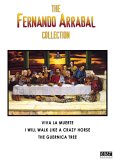Viva La Merte (1970) was surrealist playwright and all-around provocateur Fernando Arrabal’s feature film debut. Set during the aftermath of the Spanish Civil War, this is the deeply autobiographical (no matter how bizarrely presented) story of the a young boy whose father was betrayed by his mother to the security forces of the Fascist General Franco. Oedipal nightmares, extreme violence and brutal eroticism are present in force.These elements are present in the other two films as well. I Will Walk Like a Crazy Horse (1973) has a man suspected of killing his mother flee into the desert, where he falls in love with a holy man, and when the two return to society, our hero is disgusted by what he finds.
The Guernica Tree (1975) is arguably the most brutal of the three films, which should come as no surprise, given the subject matter. We are back in Spain again, during the Civil War, and the action shifts from a backwards provincial town to the doomed Gernica.
By no means will these films appeal to everyone, but nor are they supposed to. They are deliberate attacks on the audience (Arrabal was part of the “panic movement” in theatre), and the assaults come both in the form of taboo-busting images as well as attacks on traditional narrative structure. The Bunuel influence is apparent, of course, as is the fact that Arrabal was a contemporary and collaborator of Jodorowsky’s, though for my money Arrabal is more interesting politically and less of self-worshipping wanker than the director of El Topo.
Audio
The sound is the original mono, and on the first two discs, this is adequate. The oldest film sound the cleanest, barring a bit of static.. Crazy Horse has some noticeable distortion. The real problem is The Guernica Tree, which blasts static out of the rear speakers.
Video
Allowing for the age of the films and the fact that they were hardly blockbuster productions,l the prints are in very good shape. Damage is next to nil, colours are excellent, and grain is minimal. All three films are presented in the 1.78:1 anamorphic widescreen ratio, and there is some noticeable cropping at the edges of the screen on The Guernica Tree.
Special Features
The first two films have interviews (conducted in French) with Arrabal. The discussions are, it should come as no surprise, interesting, quirky and heady, though the first one seems to drop us into the middle of a conversation with little context. Guernica has, instead of an interview, footage of Arrabal on a recent trip to Hollywood, interviewing passers-by and generally making mischief. Each disc has a lobby card gallery, and a trailer. Muerte and Crazy Horse have each other’s, while Guernica has its own. The menus are basic. Each disc also comes with extensive and very informative liner notes.
Closing Thoughts
Difficult but rewarding viewing, this is a major release from Cult Epics.






